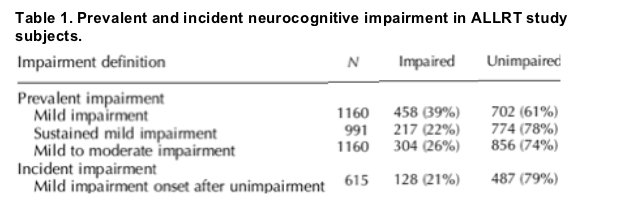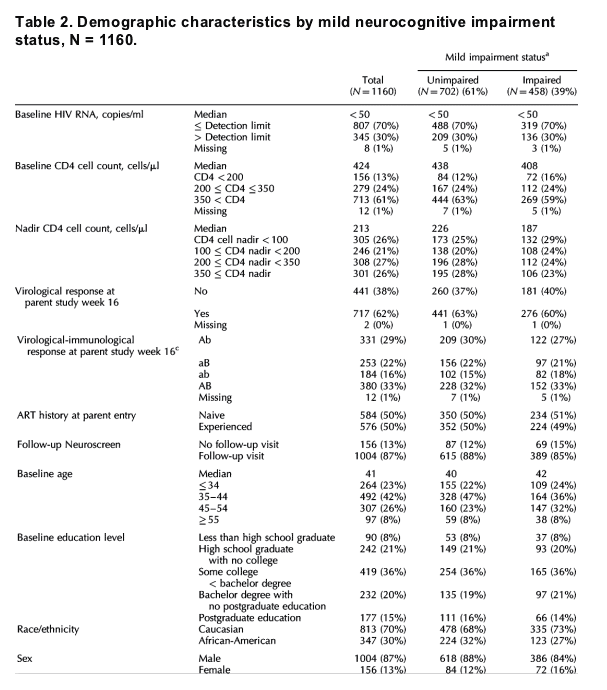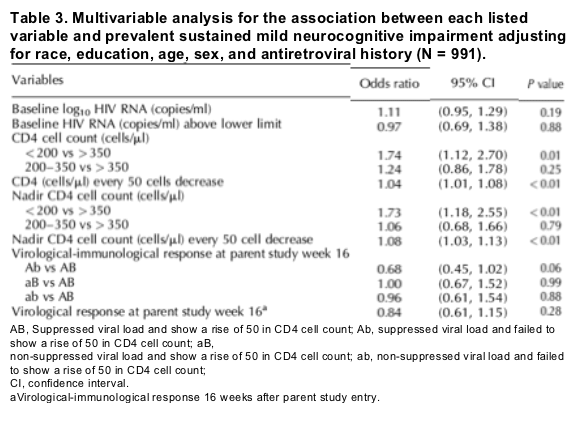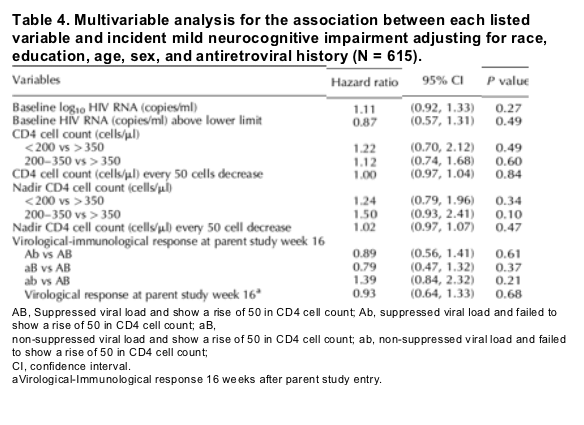| |
The prevalence and incidence of neurocognitive impairment in the HAART era
|
| |
| |
Download the PDF here
AIDS:Volume 21(14)September 2007p 1915-1921
Robertson, Kevin Ra; Smurzynski, Marleneb; Parsons, Thomas Da; Wu, Kunlingb; Bosch, Ronald Jb; Wu, Juliab; McArthur, Justin Cd; Collier, Ann Ce; Evans, Scott Rb; Ellis, Ron Jc
From the aDepartment of Neurology, UNC, Chapel Hill, North Carolina, USA
bCenter for Biostatistics in AIDS research, Harvard School of Public Health, Boston, Massachusetts, USA
cDepartment of Neurology, UCSD, San Diego, California, USA
dDepartment of Neurology, Pathology and Epidemiology, Johns Hopkins University, Baltimore, Maryland, USA
eDepartment of Medicine, University of Washington, Seattle, Washington, USA.
"....By the most conservative estimate, an assessment of neurocognitive function revealed that 26% of subjects selected from the ALLRT study were cognitively impaired at their baseline Neuroscreen....226 (58%) had a follow-up visit at which their test scores indicated they were neurologically unimpaired. This may be related to the favorable effects of HAART on neurological function. This has also been noted in other cohorts (J.C. McArthur, NEAD, personal communication).
There was a relationship between immunological status and prevalent neurocognitive impairment, but we did not find substantial evidence to suggest that virological factors were associated with prevalent neurocognitive impairment. In the pre-HAART era, viral set points (i.e. plasma HIV-RNA levels very early in infection) were clearly associated with the subsequent development of HIV dementia [27], and CSF HIV-RNA levels correlated with the severity of neurological disease [28,29]. Recent HAART era studies, however, have not found a relationship between plasma or CSF HIV-RNA viral loads and neurological dysfunction in individuals taking HAART [3]. Alternatively, viral suppression as a result of current ART may restrict the range of plasma HIV-RNA levels, and therefore reduces the ability to observe the relationship between virological status and prevalent neurocognitive impairment. Although it is worrisome that incident impairment was 21% in this study, this may be moderated by improvement over time. Nevertheless, the observed decline in neurocognitive functioning despite ART is consistent with the hypothesis that viral replication in the CNS may not be well controlled in some patients treated with HAART, perhaps because antiretroviral drugs may not penetrate adequately into the CNS...Future studies of the prevalence and incidence of HIV-associated neurocognitive decline should examine CNS penetration of antiretroviral regimens, which may be relevant to HIV-associated neurocognitive disease. In addition, adherence should be examined because cognitive impairment may affect medication adherence or vice versa....Even with HAART therapy, our data suggest that there is a significant subset of subjects on ALLRT who have mild-to-moderate neurocognitive impairment, and a subset that develop impairment after starting HAART. Additional studies are needed to understand the mechanisms behind neurocognitive impairment and to develop strategies to prevent and treat this condition."
Abstract
Objectives: HAART suppresses HIV viral replication and restores immune function. The effects of HAART on neurological disease are less well understood. The aim of this study was to assess the prevalence and incidence of neurocognitive impairment in individuals who initiated HAART as part of an AIDS clinical trial.
Design: A prospective cohort study of HIV-positive patients enrolled in randomized antiretroviral trials, the AIDS Clinical Trials Group (ACTG) Longitudinal Linked Randomized Trials (ALLRT) study.
Methods: We examined the association between baseline and demographic characteristics and neurocognitive impairment among 1160 subjects enrolled in the ALLRT study.
Results: A history of immunosuppression (nadir CD4 cell count < 200 cells/ƒÊl) was associated with an increase in prevalent neurocognitive impairment. There were no significant virological and immunological predictors of incident neurocognitive impairment. Current immune status (low CD4 cell count) was associated with sustained prevalent impairment.
Conclusion: The association of previous advanced immunosuppression with prevalent and sustained impairment suggests that there is a non-reversible component of neural injury that tracks with a history of disease progression. The association of sustained impairment with worse current immune status (low CD4 cell count) suggests that restoring immunocompetence increases the likelihood of neurocognitive recovery. Finally, the lack of association between incident neurocognitive impairment and virological and immunological indicators implies that neural injury continues in some patients regardless of the success of antiretroviral therapy on these laboratory measures.
Introduction
Since the introduction of highly active antiretroviral therapy (HAART) in 1996, many HAART-treated patients have shown durable and often complete suppression of HIV replication [1]. These newer antiretroviral drug combinations have led to a reduction in AIDS-related morbidity and mortality [2]. HAART has been found to be effective in suppressing both plasma and cerebrospinal fluid (CSF) HIV-RNA levels [3,4]. Decreased incidence rates of HIV-associated neurological disease, central nervous system (CNS) opportunistic infections [5,6], and neuropathological studies have confirmed these findings [7]. Studies have, however, found that the prevalence of cognitive dysfunction remains at approximately 20% [5,8]. The extent to which HAART leads to a reduction in the incidence and prevalence of HIV-related cognitive impairment remains unclear.
HAART and encephalopathy
With the increasing resistance of HIV strains to antiretroviral drugs, some have predicted that there may be a resurgence in the frequency of HIV encephalitis, or that resistant virus within the CNS may become more frequent [9]. Langford et al. [8] argued that despite the successes of HAART, more severe forms of HIV encephalitis appear to be emerging as the HIV epidemic matures. The prolonged survival of HIV-infected patients lengthens the brain's exposure both to the direct consequences of replicating HIV-1, and also to the indirect consequences of toxic HIV proteins and pro-inflammatory cytokines. In the examination by Neuenburg et al. [10] of postmortem neuropathological reports for a consecutive series of 436 HIV-seropositive patients who died between 1985 and 1999, the frequency of HIV encephalitis actually increased over time. It is suggested that this may reflect the longer survival times in the HAART era, with the increased potential for the development of encephalitis during periods of virological escape.
Cognitive and motor impairment is still recognized as a common complication of HIV infection, even in HAART-treated patients, and is estimated to occur in 20% of individuals with advanced HIV disease [5]. In HIV-1-associated minor cognitive/motor disorders, patient profiles are characterized by impaired motor speed and working memory [11]. By contrast, in early disease attention, visuoconstructive abilities, and memory are relatively unimpaired [12-14]. In HIV-1-associated dementia, patient profiles are marked by behavioral changes, attention and executive dysfunction, psychomotor slowing, and memory impairment [15]. Since the introduction of HAART in 1996, the incidence of HIV dementia has decreased by approximately 50%, and there is accumulating evidence that the phenotype may be less severe than in the pre-HAART era [16]. The mean CD4 cell count for new cases of HIV dementia is increasing [5], but it still generally occurs in the setting of moderate to advanced immunosuppression. Some antiretroviral regimens have poor penetration into the CNS through the blood-brain barrier, and may not reverse neurological deficits as well as regimens with superior CNS penetration. With suboptimal antiretroviral exposure within the CNS parenchyma, there is a higher probability that HIV can continue to replicate in the CNS, possibly leading to the onset or progression of HIV-related neurological disease [17,18]. It is also probable that some patients receiving antiretroviral therapy (ART) over time may develop resistance mutations leading to the failure to suppress viral replication and an eventual decline in CD4 cell counts. With that scenario, the incidence of HIV-associated neurological disease may increase.
The primary aim of this study was to evaluate factors associated with prevalent and incident neurocognitive impairment among a cohort of individuals who participated in randomized HIV treatment studies.
Discussion
By the most conservative estimate, an assessment of neurocognitive function revealed that 26% of subjects selected from the ALLRT study were cognitively impaired at their baseline Neuroscreen. This rate of impairment demonstrates that a significant subset of individuals have measurable cognitive dysfunction even after starting at least 20 weeks of HAART. This may impact on everyday functioning or even medication adherence [26].
The rate of neurocognitive impairment decreased at subsequent visits. Possible explanations for decreased impairment include benefit through sustained ART effects, practice effects on the neuropsychological tests, or attrition of those with disease progression (i.e. survival bias). Neurocognitive impairment was transient in some subjects, and impairment status could fluctuate over time. In our analysis, we found that among 389 participants with prevalent mild impairment at the first neurological visit who had at least one follow-up visit, 226 (58%) had a follow-up visit at which their test scores indicated they were neurologically unimpaired. This may be related to the favorable effects of HAART on neurological function. This has also been noted in other cohorts (J.C. McArthur, NEAD, personal communication).
There was a relationship between immunological status and prevalent neurocognitive impairment, but we did not find substantial evidence to suggest that virological factors were associated with prevalent neurocognitive impairment. In the pre-HAART era, viral set points (i.e. plasma HIV-RNA levels very early in infection) were clearly associated with the subsequent development of HIV dementia [27], and CSF HIV-RNA levels correlated with the severity of neurological disease [28,29]. Recent HAART era studies, however, have not found a relationship between plasma or CSF HIV-RNA viral loads and neurological dysfunction in individuals taking HAART [3]. Alternatively, viral suppression as a result of current ART may restrict the range of plasma HIV-RNA levels, and therefore reduces the ability to observe the relationship between virological status and prevalent neurocognitive impairment.
In this analysis we adjusted for possible differences in neurocognitive performance based on ethnicity using ethnicity-based norms. Only Caucasian and African-American ethnic normative data were available, however, necessitating the need to exclude data from subjects who reported Hispanic or other ethnicity [25,30]. Although excluding these subjects from the analysis was not ideal, including them without appropriate norms would have provided biased results, which would be difficult to interpret. Work to develop appropriate Hispanic normative data for neuropsychological tests is needed, and these norms are under development.
Although it is worrisome that incident impairment was 21% in this study, this may be moderated by improvement over time. Nevertheless, the observed decline in neurocognitive functioning despite ART is consistent with the hypothesis that viral replication in the CNS may not be well controlled in some patients treated with HAART, perhaps because antiretroviral drugs may not penetrate adequately into the CNS [31,32]. Future studies of the prevalence and incidence of HIV-associated neurocognitive decline should examine CNS penetration of antiretroviral regimens, which may be relevant to HIV-associated neurocognitive disease. In addition, adherence should be examined because cognitive impairment may affect medication adherence or vice versa [26].
One limitation of this study is that the brief screening neuropsychological battery includes only three measures: Trailmaking Test A, Trailmaking Test B, and the WAIS-R Digit Symbol Test. Although this neuropsychological battery is brief, these tests have been found to be sensitive in detecting HIV-related neurocognitive changes [22,23]. A recent validation study reported on the sensitivity and specificity of this screening battery to a more robust battery, and found the screening battery to have high specificity [33]. There is an inherent trade off in using a screening battery as opposed to a more complete neurological assessment, as not all relevant domains of functioning are characterized. The advantage is being able to sample a large population serially. Although it may be helpful to use additional tests, Van Gorp et al. [23] found notable deficits among HIV-1-immunocompromised patients on non-verbal memory and speeded psychomotor tasks, despite the preservation of attention and concentration, language skills, and most visuospatial construction abilities. Future longitudinal studies could extend these results using a broader battery, with more demanding tasks such as measures of verbal and non-verbal memory, attention and concentration, language skills, and visuospatial construction.
Even with HAART therapy, our data suggest that there is a significant subset of subjects on ALLRT who have mild-to-moderate neurocognitive impairment, and a subset that develop impairment after starting HAART. Additional studies are needed to understand the mechanisms behind neurocognitive impairment and to develop strategies to prevent and treat this condition.
Methods
Participants and procedures
We evaluated 1160 African-American and Caucasian subjects from the AIDS Clinical Trials Group (ACTG) Longitudinal Linked Randomized Trials (ALLRT) study. A total of 294 subjects of Hispanic ethnicity and 44 subjects of other ethnicity were also assessed, but because demographic normative means used for neuropsychological analyses were not available for Hispanic individuals, or individuals of other ethnicities, they were excluded from the analyses. ALLRT is a prospective observational cohort study consisting of subjects participating in ACTG clinical trials who have been randomly assigned to ART, immune-based therapies, or strategies for anti-HIV intervention. In ALLRT, prospective follow-up begins when subjects enter their parent treatment study, continues within the context of the parent protocol until parent protocol participation ends, and then continues within the ALLRT study. For this analysis, subjects were enrolled from one of 14 parent ACTG studies, which included three studies for antiretroviral-naive subjects (ACTG 384, A5014, A5095), nine studies for antiretroviral-experienced subjects (364, 372, 373, 398, 400, A5025, A5057, A5064, A5076) and two studies that entered both naive and experienced subjects (347, 388). Each of the 14 studies was a prospective randomized clinical trial that included treatment regimens with at least three antiretroviral agents (excepting 19 subjects from 347 who were randomly assigned to monotherapy, but subsequently initiated three antiretroviral agents). Antiretoviral regimens varied both within study (treatment arm) and between study, and included abacavir, didanosine, lamivudine, stavudine, zidovudine, efavirenz, nevirapine, amprenavir, indinavir, lopinavir/ritonavir, nelfinavir, ritonavir, and saquinavir. In addition to the randomized study treatments, some of the studies also included other antiretroviral agents in optimized background treatments.
Every 48 weeks while on ALLRT, subjects complete tests designed to screen for HIV-related neurological disease. Subjects were included in this analysis if they completed one Neuroscreen evaluation at least 20 weeks after parent study entry. Inclusion after parent study week 20 was to exclude Neuroscreen evaluations obtained either before or in the first weeks of initiating or changing ART. The Neuroscreen has two components: (i) the Brief Peripheral Neuropathy Screen, which examines HIV-related peripheral nerve dysfunction [19]; and (ii) the Brief Neuro-Cognitive Screen, which examines HIV-associated cognitive motor disorders. The Brief Neuro-Cognitive Screen battery consists of the Trailmaking Test A and B [20] and the WAIS-R Digit Symbol subtest [21]. These tests were chosen because they are sensitive in detecting both HIV-related neurocognitive changes [22,23] and treatment effects upon CNS functions [24]. The raw test score of each measurement is standardized using demographic-adjusted normative means, which adjust for sex, age, education, and ethnicity (Caucasian and African-American) [25]. A standardized score is calculated by subtracting the appropriate normative mean from the raw score then dividing by the appropriate normative standard deviation. In order to have a more comprehensive characterization of neurocognitive impairment, we defined two levels of impairment. The two levels were: (i) mild: a subject's performance was one standard deviation below the mean on two Neuroscreen tests or two standard deviations below the mean on one test; (ii) mild to moderate: the subject's performance was one and a half standard deviations below the mean on two tests or two standard deviations below the mean on one test. As neurocognitive impairment can be transient, we were also interested in estimating sustained impairment. We defined prevalent sustained impairment as impairment on both the first and second Neuroscreen, in which the first Neuroscreen was at least 20 weeks postparent enrollment. The incidence of neurocognitive impairment was estimated for subjects who were unimpaired at their first neurological assessment and who had at least one follow-up neurological evaluation.
Statistical considerations
The first neurological assessment included was at least 20 weeks from antiretroviral randomization; this first neurological assessment is considered baseline in these analyses, and baseline covariates considered in analysis were taken at the time of this first neurological assessment. Subsequent follow-up neurological visits were every 48 weeks. Pearson's chi-square was used to assess the association between baseline and demographic characteristics and prevalent neurocognitive impairment status. Multivariable logistic regression was used to identify factors related to impairment status, by examining the relationship between each baseline factor and impairment, while controlling for age, race, education, sex, and history of antiretroviral use at parent study entry. Cox regression was used to describe factors that influenced time from baseline neurological assessment to incident impairment. Subjects without incident impairment at any follow-up neurology visit were censored at the time of their last follow-up neurology visit.
The primary purpose of this analysis was to characterize prevalent and incident neurocognitive impairment in HIV-infected subjects, and to examine the associations of virological and immunological status with neurocognitive performance. We thus evaluated the virological status and HIV-RNA viral load in plasma at baseline as 'primary factors'. HIV-RNA assays were specified by the parent protocol. Almost all HIV-RNA assays (97.4%) used the Roche ultrasensitive method, with a lower limit of 50 copies/ml. Additional factors included in the evaluation were: baseline CD4 cell count, nadir CD4 cell count, and virological status after ART initiation (16 weeks after parent study entry). The following covariates were also evaluated: years of education, age, sex, race/ethnicity, and history of ART.
Viral load was transformed to the log10 scale for modeling. CD4 cell count and CD4 cell nadir were transformed so an odds ratio or risk ratio was presented for every 50 cell reduction in CD4 cell count. Indicator variables for a CD4 cell count and nadir CD4 cell count of less than 200 cells/ƒÊl were created for use in modeling. Virological response was present if a subject had an HIV-RNA level below the lower limit of detection after treatment initiation (16 weeks after parent study entry, either 50 or 400 copies/ml, as indicated by the test used). Continuous variables for age and years of education, and indicator variables for history of ART at parent study entry (ART experienced versus ART naive), sex (female versus male), and race (Caucasian versus African-American) were created for use in modeling.
Results
Prevalent neurocognitive impairment
A total of 458 subjects out of 1160 (39%) were classified as having mild neurocognitive impairment at the first neurological assessment (Table 1). Using a more stringent cut-off to define impairment, 304 (26%) of the 1160 subjects had mild to moderate impairment at their first visit. Of the original 1160 subjects, 991 had at least one follow-up Neuroscreen, and of these, 217 (22%) had sustained mild impairment. Of the 458 subjects classified as having mild impairment at baseline, 389 subjects had at least one follow-up visit, indicating that 217 out of 389 subjects (56%) impaired at baseline sustained impairment at follow-up, or from another view, 44% improved with treatment.

Mild impairment: one SD below mean on two tests/2 SD below on one test (Baseline; 1st neurological assessment). Sustained mild impairment: one SD below mean on two tests/2 SD below on one test (1st and 2nd visit). Mild to moderate impairment: 1.5 SD below mean on two tests/2 SD below on one test (1st visit). Mild impairment onset after unimpairment: one SD below mean on two tests/2 SD below on one test on a follow-up visit after an unimpaired visit [mild impairment (1 SD below mean on two tests/2 SD below on one test) was used to define prevalent impairment/ unimpairment status at previous visits].
Baseline HIV RNA (P = 0.97), baseline CD4 cell count (P = 0.14), and virological response at parent study week 16 (P = 0.38) were not related to prevalent mild impairment, whereas nadir CD4 cell count was on the cusp (P = 0.06; Table 2). A history of antiretroviral use (P = 0.68) and education (P = 0.89) were not related to impairment, whereas age was related to prevalent impairment (P less than 0.01).

Among 991 subjects evaluated for prevalent sustained mild impairment, every 50 cell decrease in total CD4 cell count at the baseline [P < 0.01; odds ratio 95% confidence interval (CI) 1.01, 1.07] and every 50 cell decrease in CD4 cell nadir before the baseline (P < 0.01; CI 1.03, 1.13) were significantly associated with prevalent impairment (Table 3). The virological response 16 weeks after parent study entry and baseline HIV RNA were not significantly associated with prevalent impairment.

Incident neurocognitive impairment
A total of 615 subjects were neurologically normal at their baseline neurological assessment and had a follow-up neurological visit. Of these, 128 subjects (21%) subsequently became impaired (Table 1). Analyses of the association between covariates and incident neurocognitive impairment (defined as mild impairment) were based on these 615 subjects. Multivariate proportional hazards regression modeling adjusting for age, race, sex, education, and antiretroviral history did not reveal any significant associations (Table 4).

|
|
| |
| |
|
|
|